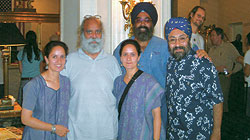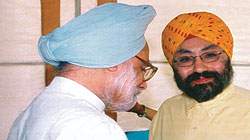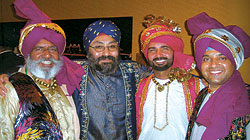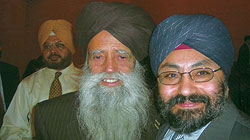|
Bicky Singh, President and CEO of Future Computing Solution Inc and SecureMart.com based at Yorba Linda in Southern California, is a man with path-breaking ideas. This Net-wired sikh finds amazing similarities between his Sikh faith and the Internet. “Every gurdwara has four doors. Which means anyone (of the four castes) can come in. The same applies to the Internet. Whether it is IBM or a start-up company, both are on the same platform. The internet and the Sikh religion don’t discriminate,” laughs the man who probably has the world’s largest collection of
turbans.
This techie has put his religion on the information superhighway to disseminate its message to the wider world through his portal
www.Sikhpoint.com.
As he explains, “The internet is a real boon for smaller religions like Sikhism. We are just a few million and scattered around the world. The preserve our culture, we need connectivity. That’s why in 1998 my wife and I launched this portal to cater to religious, social, cultural, professional and personal needs of the community – kids, adults and seniors. We get more than 80,000 hits a day.”
 |
 |
WITH ELITE ARTISTS:
Bicky Singh with Singh Twins Amrit and Rabindra, their father and world renowned hymn singer Dya Singh of Australia (in black turban); (Right) TURBAN TIPS FOR PM: Bicky Singh with Manmohan Singh in New Delhi |
The biggest problem of Sikh children abroad, he says, is their lack of knowledge of Pubjabi. “When these kids go to gurdwaras, they don’g follow the kirtan and bani in the Gurmukhi script. Sikhpoint.com attracts this net-savvy generation through animations, video games and fun-filled tutorials, and then leads them on to exciting sections on Sikh religion and culture. We have another channel called Sikhpoint Positivemedia Visibility Channel to portray role models for our kids,” he says.
Sikhpoint.com also has a section on greeting cards carrying the Sikh message. “On Teachers’ Day three years ago, my children asked, ‘Dad, why shouldn’t we have greeting cards on the portal?’ That’s how we started this section. Last year when my kids sent these greeting cards to their teacher on Teachers’ Day, he said he was amazed by the richness of the Sikh religion. With over 1,400 animated greeting cards in various categories, we have one of the best collections on any Sikh site.”
Immediately after Bicky Singh launched the portal, 9/11 happened. The Sikhs were mistaken for Muslims and became targets of the racial backlash. “We invited California Lt. Governor Cruz Bustamante, senators and the press to the Orange County gurdwara to explain to them about Sikhism. This helped the community. In those troubled times, we also launched Sikhmediapoint on our portal to give guidance to the community,” he says.
 |
 |
|
At the opening of the Sikh Art Gallery at the Smithsonian Institute of Washington DC |
Bicky Singh with the world’s oldest marathon man, Fauja Singh, of Britain |
Bicky Singh also hit upon a subtle way of creating awareness among people about the Sikh religion. “Look, if you try to tell people about your religion, they fear you are trying to convert them. But if you convey your message subtly, people don’t feel threatened. That is what we have done by packaging the Sikh message in art form.”
Sikhpoint.com designs, prints and distributes free about 30,000 calendars, depicting various aspects of Sikh heritage. “By distributing this beautiful calendar among law enforcement agencies, legislators, museums (like Getty Center and Smithsonian) and teachers’ associations we have made them aware about Sikhism. These calendars carry great pieces of Sikh art by Sikh artists, with a description. These calendars have raised the visibility of Sikh art and artist like Singh Twins Amrit and Rabindra from Britain whom we featured in 2005. Some museums have inquired about Sikh art and we are in talks with them,” he reveals.
Realizing that the Sikhs were targeted after 9/11 because the American people didn’t know that they were different from Muslims, Bicky Singh decided to make common people aware about his faith. “The Sikhs were targeted because we never tried to educate Americans about ourselves. With the help of Orange County and Buena Part gurdwaras, we started feeding 450 homeless people in two shelters every weekend. Over time, these Americans have realized how wonderful and generous Sikhs are. The law enforcement personnel present at these shelters at the time of food distribution also know that the Sikhs are a difference people.”
Giving an example of how this approach has paid off, he says some time ago he was in Santa Ana with two American friends. “Suddenly, we heard a noise and saw people waving at us. My friends thought I might be in trouble because of my turban. Well, what actually happened was this: some people from the shelter where we serve food on weekends recognized me. In appreciation of our service, they started waving at me. I felt great,” says the man who believes in unique methods to drive home his
message.
In his native India, Bicky Singh is helping his people in his own unique way. “Like other organizations, we don’t adopt villages or children. At our office in Mohali near Chandigarh, we train the rural youth in computers. These trained boys and girls have found gainful employment. We want to save the unemployed youth from falling prey to drugs, alcoholism and other vices rampant in Punjab today. Some of these youth have been absorbed in my company’s Chandigarh office.”
In its Indian mission, Sikhpoint.com has teamed up with diaspora individuals and organizations. “Look , many individuals and organization want to do something in India, but they are unable to go there. So we tell them that this (computer training) is our strength and that we already have a presence there. Working with loose networks rather than big organizations helps,” he
says.
Bicky Singh stands apart for his novel methods. And he stands apart for his coloruful turbans. In fact, so huge is his collection of bright-coloured turbans that he could easily get his name into the Guinness Book of Records for their sheer number. “Turbans are my passion. I may be the only Sikh in the world with more than 500 patterned turbans with matching ties, though I once met a guy who had 200 printed turbans,” he says.
He generates his own designs on computer and e-mail them to New Delhi for creating matching turbans in Ghaffar
Market.
Interestingly, post 9/11 he created the first turban with the American flag on it. “And I have created turbans for other specific occasions like Vaisakhi, Halloween, St. Patrick’s Day, and Independence Day.”
Bright colour, he says, are his passion. “When I was a student at California State University, my bright-coloured turbans made people curious about me. This interaction helped me explain my religion to them.”
His colourful turban impressed even Indian Prime Minister Manmohan Singh when Bicky Singh met him in New Delhi in 2004. “The Prime Minister asked me about my turban. And I promised to send him one soon. Even the California Lt. Governor complimented me for my turbans, saying their colours are representative of our cultural diversity,” says Bicky Singh who serves on the California One Commission.
Shoes are his other obsession. “Once I was hauled up by customs guys in Hawaii while bringing many pairs of shoes from India. They couldn’t believe me when I told them these pairs were for personal use,” he laughs.
Amazingly, Bicky Singh is not only a great collector of Sikh original art and coins but also a creator of some unusual artwork with recycled material. One such creation is called Emergence into Chaos.
Created by him with wood, computer circuit material, auto parts, spent 7.62mm cases (AK-47), spent 12-gauge shotgun shells, transformer plates, wire, lead, refrigerator parts, tin, brass, oil paint, children’s hospital armbands, spring stock, nails, and screws, this sculpture is an expression of his puzzlement at the chaotic world.
“This sculpture came about for several reasons. One, I had interest in the civil unrest in the Balkans. Two, I am fascinated by the ability of humankind to bring forth new life despite this chaos. While growing up in India, I wondered how societies in turmoil still carried on with the most basic of their functions – bringing forth new life,” he says.
Accordingly, at the center of his creation is an infant surrounded by all the internal mechanisms that provide life to the new child. The child is submerged in the soup of stylized DNA, represented by the bits of colour floating around. Love, Terror, Joy, Fear, Anguish and above all, Hope breathe in and out of the child’s lungs. Her brain is being fed by her parents’ sum total of their imprint, but more importantly, her mother’s imprint, making sure the bloodline is
continued.
The child is seen reaching out toward what is the drama of war and chaos. The colours above offer no comfort for this new life, save the white hand of hope, which reaches down to help this new life survive for a better tomorrow.
At the bottom lie many pieces of what the mother shares with her unborn infant. Food, Energy, Warmth, Love and Hope are passed from the mother to the infant. What is spent gets recharged and then passed on again in an endless loop until the child has pressed through to life awaiting her. “That’s how life has found its way through since the beginning of humankind,” he explains.
Born in Agra, Bicky Singh was raised in New Delhi. After his graduation, he joined the Delhi IIT for his masters in systems engineering. “In 1983, I came to California State University, Fullerton, for higher studies. While still a student, I was fortunate to get a job with a start-up computer company in Orange County. I learnt the business ropes with them. The outsourcing of mainframe programming work to India was just picking up in the late 1980s when in decided to start my own business,” he says.
In 1990, Bicky Singh started Future Computing Solutions Inc headquartered at Yorba Linda, where President Richard Nixon was born. “We were the first technology business in this town which is known as the ‘bed-room’ community. The day we opened in 1990, the mayor called to congratulate us for bringing the IT business to his town. We have another office in San Francisco and one in India,” he says. “
Future Computing Solutions Inc (FCS) provides solutions for real business problems in today’s competitive landscape. It leverages a diverse portfolio of resources to service the customer’s needs – whether it is a large corporate customer, a small business owner or consumer. The organization has stayed competitive because of its unique business model by investing in resources in the emerging trends, by recognizing and understanding the customer’s needs, and by having multiple channels of reaching out to various types of customers beyond simply providing IT products,” Bicky Singh explains.
According to him, his unique business model helped FCS weather the dotcom bust in the mid-to-late 1990s. “The key to our survival has been to invest in training, top-notch human resources and emerging technology. Our services are backed up with over 180 employees in three locations: corporate office in Yorba Linda, our sales and service location at Alameda, and offshore location in India,” he says.
On his rolls are many MBAs and Ph.Ds, and they come from Central and South America, Vietnam, China, Taiwan, India, Europe and the US. “Because of our inner diversity, we are in the unique position to understand the needs of the customers – large and small. FCS has made tremendous investment in technology, such as state-of-the-art lab for solutions demonstration in the area of enterprise storage, communication and VOIP, data warehouse / business intelligence and security. Investment in human and resources has allowed us to ‘stay ahead of the curve’ and be competitive in the global market-place.”
His Indian operations, started near New Delhi in 1999, have grown from providing development services to business process outsourcing. “Our development expertise includes: business-to-customer (B2C), business-to-business (B2B), portals, intranets, application development and data warehousing / business intelligence services. With the investment in an off-shore facility, we are able to leverage the expertise of FCS India in a 24x7 fashion,” he says.
Bicky Singh added another feather to his colourful turban in December 2003 when FCS launched an online business called SerucreMart.com to sell electronics, home entertainment products, IT products, and kitchen and home appliances.
The artistic side to this techie is obvious even at his workplace. In the lobby of his head office hangs a beautiful piece of artwork, titled Circular Metal, created by him. “This just about sums up my business philosophy,” he beams.
Pointing to his creation, he says, “A circle has no beginning and no end. In this work, the circular form in the background is rather like a cycle. It symbolizes the repetition of time that is endless. The outer edge is notched in a gear-like fashion. This perfectly mimics the daily ups and downs of the business cycle. One moment sales and projects are at a fever-pitch and the next moment inactivity abounds. The inner circle presents a more idealistic view. Its edge is smooth, representing a view of the company over time. It is, at once, the final result and continual goal of the company.”
There are two triangles within the circular shape. Only their farthest points extend beyond the circle, hinting at the company’s possibilities of growth. “The left inner triangle represents the forces that the company faces every day. In one corner of the triangle are the suppliers. They feed the necessary materials to the company to create products and services. At the other corner, stand the employees. They are the lifeblood of the company. At the apex of the triangle are the customers. This triangle serves to strike a balance among all the three, integrating them into a whole,” he points out.
The right inner triangle represents the internal balances of power within the company. “At the right corner are the salesmen. They are commissioned and naturally move at a frenetic pace. The other corner represents the credit department. They hold the power to affirm or deny potential sales. Naturally, this arrangement creates a tension that must be arbitrated by the CFO, residing at the top of the triangle. The CFO must balance the dichotomy of passion and methodology while maintaining the flow of the work and protecting the company’s interests,” winks the
CEO.
A chaotic potpourri of shapes is scattered on the planes of the triangles. Pointing in every direction, they threaten to collide. “These represent individual agendas. Ideally, all components must maintain a balance. Internal harmony is the goal. Although in this construction, there are a myriad of smaller components that make up the whole, they are no less important. The strength of the one leads to the strength of the many,” elaborates Bicky Singh.
The construction reveals not only the inner workings of the company but also its inner voice. “Balance, harmony and order flow through this construction, as they do within the company. It is never-ending cycle with many parts, all of them moving towards a common goal,” he adds.After all, success demands it.
—This article has been excerpted with permission from the
book California Dreams by Gurmukh Singh.
|